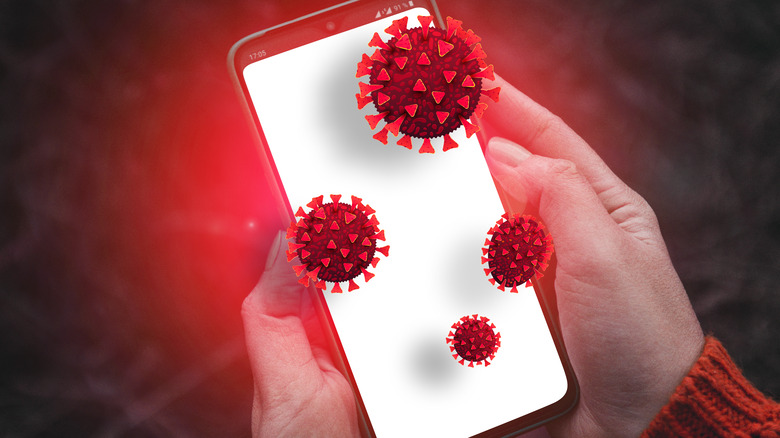Your Smartphone Could Be A Haven For Hidden Allergens
In 2017, Time reported that mobile phones carry 10 times more bacteria than the average toilet seat. "Because people are always carrying their cell phones, even in situations where they would normally wash their hands before doing anything, cell phones do tend to get pretty gross," said epidemiologist Emily Martin. What's more, these gadgets may harbor antibiotic-resistant bacteria, viruses, fungi, and other germs, according to a recent study featured in Scientific Reports.
As the researchers note, most people touch their phones about 2,000 times a day. Some also touch their faces or eat afterward, which can lead to bacterial infections. The above study, which was conducted on 26 mobile phones, found they were all contaminated with pathogens. Together, these devices carried over 11,000 microorganisms, including 5,714 bacteria, 228 viruses, and nearly 2,100 genes associated with viral infections and antibiotic resistance.
Perhaps not surprisingly, our go-to gadgets could also be a haven for hidden allergens, says the American College of Allergy, Asthma and Immunology (ACAAI). As it turns out, these gadgets can harbor chemicals and other potentially toxic compounds linked to allergic reactions, asthma, and respiratory problems.
The surprising link between smartphones and allergic reactions
One of the highlights of the ACAAI 2022 Annual Scientific Meeting was a study suggesting that mobile phones are reservoirs for allergens. Researchers used simulated phone models to determine their level of contamination. The study revealed that our go-to gadgets carry beta-D glucans (BDGs), cat and dog allergens, and other potentially harmful compounds.
"BDGs are found in fungal cell walls and have been found in many environments and surfaces, causing chronic airway and irritant symptoms," explained research intern Hana Ruran, the lead study author (via the ACAAI). She and her team also discovered that mobile phones can be contaminated with endotoxins, a class of compounds occurring in the outer membrane of Escherichia coli, Klebsiella, and other bacteria. These pro-inflammatory substances have been linked to heart and kidney problems, multiple organ dysfunction, and other life-threatening conditions, noted a 2017 review published in the journal Blood Purification.
The study authors recommend cleaning your smartphone with a solution containing chlorhexidine and cetylpyridinium or a mixture of tannic acid and benzyl benzoate. These guidelines are particularly important for those with asthma or allergies, according to the ACAAI.
You can also use disinfectant wipes to clean your phone, but the chemicals recommended by the ACAAI appear to be most effective against BDGs, endotoxins, and allergens. While there are no hard rules on how often you should clean your phone, try to do it at least once a day. Also, remember to wash your hands regularly, especially before eating.

